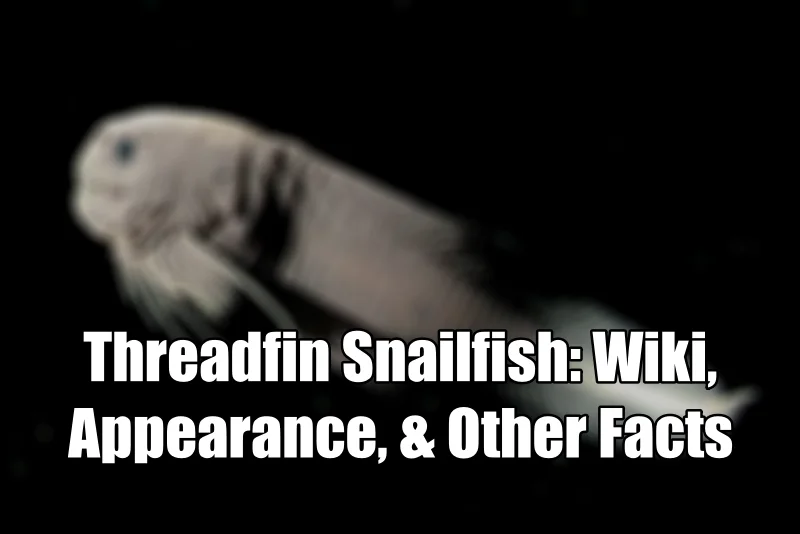Nothing in the sea compares to the extraordinarily slimy deep-sea threadfin snailfish. This species may dive as deep as 5,500 meters, which begs the question of how their small bodies can withstand pressure 500 times greater than at sea level.
This is five times the maximum pressure that the human body can bear. They also have a pleasing appearance. These appear somewhat translucent, without scales, darker than usual, and with numerous pores. In this article, let’s learn more about the amazing threadfin snailfish.
What Makes The Threadfin Snailfish So Interesting?
| Scientific name | Careproctus longifilis |
| Common name | Threadfin snailfish |
| Size | Max. 12.6 cm in males, and max. 16.2cm in females |
| Habitat | Cold waters, deep sea, 2000-5500m (about half the cruising altitude of a commercial jet) below sea level, ocean trenches, shores, hadal zone. |
| Diet | Small animals like krill, crustaceans, fish, gammarids, etc. |
| Predators | Almost no predators |
| Colors | Transparent white to brown |
| Weight | Up to 24 pounds |
| Life Span | 1-10 years |
| Price | Can be very expensive |
| About it | Harmless to humans, tadpole-like appearance, slimy body, visible open pores, etc. |
Characteristic Features of The Threadfin Snailfish
Let’s first separate its name. Snailfish indicates the fish’s tadpole-like characteristics, while threadfin emphasizes the pectoral fin’s lengthy filamentous rays. Threadfin snailfish belong to the family Liparidae, that meanwhile, grow as long as 6 inches.
Threadfin snailfish that live in the deepest sections of the ocean are minuscule, translucent, devoid of scales, and highly skilled at surviving in conditions that few other animals can.
They don’t have huge teeth or a scary frame, either. And their diet involves small animals like krill, crustaceans, smaller fish, etc. Due to the small size of this species, they are entirely harmless to humans.
Where Can You Find Them?
We frequently refer to them as benthopelagic, which denotes that they belong to a section of the water column in the demersal zone of the sea or ocean, which is located close to the seabed and the benthos. To put it simply, they are deep-sea fishes.
Native to the Arctic Ocean, northeastern Atlantic Ocean, and possibly the North Pacific, the threadfin snailfish is a species of snailfish. The deepest fish in the water doesn’t appear to be bothered by the harsh surroundings thousands of feet below the surface.
Threadfin Snailfish: Appearance
They have an unclean, slimy, and almost dusty appearance. The threadfin snailfish’s distinguishing characteristics include a pale color and a long tail that resembles a feather. This species’ skin is loose and gelatinous without scales, just like the other species in the genus.
In addition, their faces plainly show the ends of their chemoreceptors. The fish has lateral lines that go through it and terminate on its face as small dimples. Longus, as its name implies, represents length, while filum, which refers to “slender prolongations” of the upper pectoral-fin rays, stands for thread.
As a result, it swims like a cusk eel. It is colored from white to brown and has a blunt head and a large, open mouth.
If you bring one to the surface, its skin and flesh will turn translucent and slimy, displaying the dark-colored organs that are located in the body’s widest region. Hence, the coloration is only seen when they are alive in the deep water.
They appear to be grinning because of their large, flat dental plates and tiny teeth. Large eyes, nearly one-fourth the length of the head, making it pretty much a sight to remember.
Some Exciting Facts About Snailfish
- They can be found in oceans all around the world, from the shallow intertidal zones to the hadal zone, which is over 8,300 meters (27,200 feet) deep.
- Compared to other fish families, this one has a greater depth range.
- Because they only thrive in spine-chilling waters, species living in tropical and subtropical regions can only be seen in deep water.
- At their longest, snailfish can reach a maximum length of approximately 30 centimeters (12 inches). They are soft, long fish that resemble tadpoles.
- Their skins are loose, scaleless, and occasionally spiky. On the back is a long dorsal fin, and below the head is typically a sucking disk.
Genus: Careproctus
Snailfishes belonging to the genus Careproctus inhabit benthic and benthopelagic environments in the Atlantic, Pacific, Arctic, and Southern Oceans.
Its generic name is derived from a word that literally means “butt-face” in Ancient Greek. Although almost entirely isolated to very cold waters, a single species, Careproctus hyaleius, stays at hydrothermal vents.
Extremely cold waters are essentially the only habitat for the Careproctus species. Small animals are their primary prey, and some of them have odd nesting behaviors. Several different Careproctus species prey on king crabs.
As far as is known, these parasites Careproctus use a variety of king crab species and do not have a particular host. A king crab may, in rare circumstances, even carry the eggs of several species belonging to the same genus at once.
Threadfin Snailfish vs. Threadfin Seasnail
Despite having many similarities, threadfin seasnail (Rhodichthys regina) and threadfin snailfish (Careproctus longifini) can still be acknowledged by a few different characteristics.
Appearance: Firstly, they both have a distinctive tadpole-like look and are members of the same Liparidae family. Also, the following characteristics of the threadfin seasnail species set them apart: wide, flat tooth plates, and tiny teeth that are slightly visible and uniform in size.
In contrast, the lower teeth of threadfin snailfish are irregular and smaller than the upper jaw teeth. Additionally, Rhodichthys regina differs from the other species by having a rounded posterior gill cover and skin that is light (bright red in life). The northeast Atlantic and Arctic Oceans are home to the marine ray-finned fish species Rhodichthys.
Inhabitance: Although both species of fish are found in deep waters, there is a variation in the depth at which their existence is most frequently documented. The threadfin snailfish lives in deeper waters from 1900 to 3334 meters deep. While the threadfin seasnail inhabits depths of 1080 to 2365 meters.
Size: The sizes of the fish likewise varied greatly. Rhodichthys regina can grow as long as 31.0 cm (1.02 feet). On the other hand, Careproctus longifini is a smaller species, with a maximum length of 12.6 cm (about 4.96 in) for males and 16.2 cm (approximately 6.38 in) for females.
Conclusion
However, due to its natural home being extremely deep seas, the threadfin snailfish (Careproctus longifini) can only be sighted on a very infrequent basis. In fact, for the same reason, it is not extensively researched. These are still the generally recognized traits of this incredible species.
Because Rhodichthys and this species are so similar, confusion can frequently arise when studying threadfin snailfish. Still, there are many point of difference in both. For example, the depth in water where the reside, color, and skin texture. Also, they vary greatly in sizes.
Frequently Asked Questions
Q1. How large is a threadfin snailfish?
Ans. The threadfin snailfish (Careproctus longifilis) can attain a size up to 16.2 cm (in females). You must note that the male and female species differ in size.
Q2. What is the deepest living fish?
Ans. Among all living things on Earth, snailfishes are the deepest-living creatures. The Pseudoliparis snailfish inhabits an almost impossible depth of 8,336 meters below the surface.
Q3. What does snailfish eat?
Ans. Their diet involves Small animals like krill, crustaceans, fish, gammarids, etc. A snailfish’s food is also influenced by their own size.
Q4. What is the Scientific name of threadfin snailfish?
Ans. The scientific name for threadfin snailfish is Careproctus longifilis. However, this creature is often mistaken as Rhodichthys regina, which is actually the scientific name for a similar organism, the threadfin seasnail. But these two are entirely distinct living beings.
References:
- Careproctus longipinnis Burke, 1912 Longfin snailfish by fishbase
- Threadfin seasnail by Wikipedia
Also Read:

Anjali Prasad, a B. Pharm. graduate who works as a content writer for HowItSee, is based in Delhi. Except for her, not many people take the typical road from healthcare to writing. Her love of writing stemmed from her involvement in the college literature society and her early journaling at the age of 7. Hence, the love of learning and the spirit of exploration are what drew her to this career. You can find her on common social media like Instagram.
